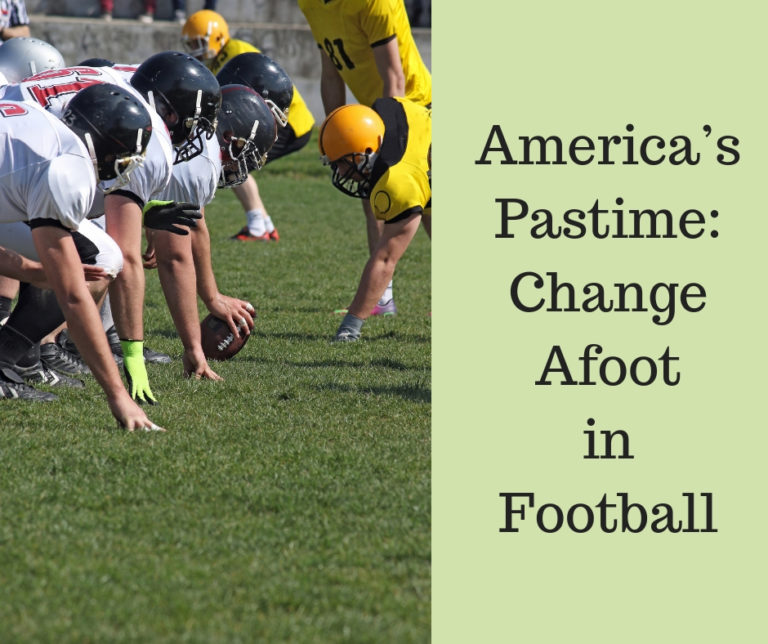Football is by definition a physically violent sport. Collisions on the field to accomplish blocking and tackling produce impact forces that inevitably lead to a sizable injury rate among the sport’s participants. Rules have been put in place over time to organize the chaos that can ensue on any given football play in order to protect the players from unnecessary risk. But the fact remains that participation in contact sports in general and football in particular includes a degree of injury risk. With the fall sport season approaching and school athletics kicking into gear, families will begin to spend a significant amount of time watching kid’s sporting events or taking in a high school/college/NFL football game over their weekends. One topic of conversation that is bound to be heard in the stands as well as from commentators during professional games has to do with the current cloud of fear regarding concussions. With recent advances in medical research and a growing body of evidence describing the potentially negative effects of repeated head trauma, there has rightfully been increasing conversation about the appropriateness of a sport that involves frequent high impact bodily collisions. This conversation becomes particularly sensitive with regard to youth football and parents’ varying comfort levels in allowing their children to participate. There has been a recent rapid rise in youth football leagues that no longer allow tackling, but have instead transitioned to flag or touch football rules. There have also been propositions to ban tackle football as a youth sport entirely, due to injury concerns. Concussion has been bearing a majority of the headlines, though awareness of risk of knee, shoulder, spine, and ankle injuries has also grown.
The National Football League has made its own attempts to curtail the risks of injuries including concussions – both with new rule implementations, as well as more formalized procedures for addressing and clearing players that have sustained injury before allowing them to return to the field. One rule change that is sure to spark ongoing debate and uncertainty as the season approaches is the new NFL Tackle Rule, which restricts players from “initiating contact by lowering their helmet and contacting another player”. Previous rules restricted “head to head” contact – with yardage penalties and possible ejections for plays ruled “intentionally malicious”. This new rule restricts any player from making initial contact with their helmet against any body part of the opponent. While that may sound like a good idea in principle to protect both the tackler and the player being tackled from head, neck, & spine injury, the obvious question and the confusion expressed by referees and players is how this rule can possibly be enforced and implemented. Multiple players have already expressed their opinions that in a fast-paced game played by very athletic individuals, it will be nearly impossible for players to do their job (tackle players with the ball) without possibly incurring a penalty with every contact. There has also been a growing consensus among players that efforts to “make tackling safer” by avoiding helmet contact has resulted in increased risk of injuries besides concussions as players purposely attempt to avoid possible penalties. A practical example of this is a possible increased risk of knee injuries as players have begun “targeting” players’ lower bodies in an effort to avoid contacting their helmets. Marqise Lee (a wide receiver for the Jacksonville Jaguars) recently suffered a probable season ending knee injury after being hit low on the legs during a preseason game. Training all of the NFL referees and sideline officials, as well as off-the-field observers of filmed game footage with the goal of applying the new regulation in a coordinated, consistent, and fair manner has proven to be another not insignificant challenge. This new tackling rule will definitely be the subject of an interesting debate as the NFL season begins, and you will most likely not be able to watch a televised game over the first half of the season without hearing a discussion about the pros and cons of the NFL’s ongoing safety plans and injury management programs. Whether any of these rules and procedures actually makes the game safer for participants is yet to be seen.
For more on the specifics of the new NFL Tackle Rule, check out this article or this summary of Frequently Asked Questions.
Symptoms following a concussion can be wide ranging and frustratingly debilitating, with ongoing complications possible long after the initial injury, when not treated properly. Here at Symmetry Physical Therapy, we offer both baseline concussion screenings (which provide a functional score to be compared to in the event of a possible injury, as well as skilled, professional treatment for recovery following concussions. If you have ongoing complications following a concussion related injury or simply want to establish a baseline prior to your athletic involvement in the coming sports season, let us know. We would be happy to discuss how physical therapy can help you to perform safely at your best.

